Cacti & Sun-Tolerant Succulents
 Cactus & Succulent Plants for Sun
Cactus & Succulent Plants for Sun
Incredible Texture, Easy to Grow and Available in Many Shapes and Sizes
There are a number of cactus varieties and sun-tolerant succulents that require little water, once established. Many are native to Arizona and all are well suited to life in the desert.
In fact, cactus plants are often thought of as the symbols of our state and as synonymous with Phoenix Arizona.
Below is a list of our favorite cacti and sun-tolerant succulents for Arizona.
Arizona Favorites
- Ocotill Cactus
- Organ Pipe Cactus
- Aloe
- Parry's Agave Cactus
- American Agave
- Red Yucca
- Firesticks Succulent Cactus
- Saguaro Cactus
- Golden Barrel Cactus
- Santa Rita Prickly Pear Cactus
- Lady Slipper Succulent Cactus
- Topsy Turvy
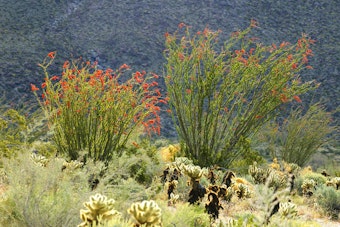
- Ocotillo Cactus (Fouquieria splendens)
Common in the Phoenix area, the ocotillo cactus is a distinctive desert plant known for its tall, spiny canes that can reach up to 20 feet in height. Despite its thorny, skeletal appearance during dry periods, it produces small green leaves and bright red flowers after rain, attracting hummingbirds and pollinators.
Native to the Sonoran Desert, ocotillo thrives in sandy, well-drained soils and is a popular choice for xeriscaping due to its drought tolerance and minimal care needs. Its flowers provide nectar for wildlife, and its flexible canes were historically used by Native Americans for fencing and medicinal purposes. In the desert landscapes in the Valley of the Sun, it serves as a striking, low-water ornamental plant that supports local ecosystems.
Ocotillos prefer rocky, well-drained soil, which mimics their natural desert habitat. When properly cared for, they can live for 60 years or more.
They thrive in full sun and have low water needs once established. During prolonged dry periods, it’s recommended to water them about once a month, but they can generally survive on very little water due to their drought-tolerant nature.
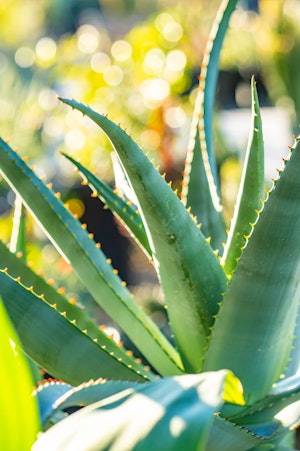
- Aloe (Aloe Barbadensis)
Probably one of the most useful plants to grow, Aloe is approximately 99% water. There are many aloe species but the most well known for it’s shape and medicinal purposes is the Aloe vera. Aloe has fleshy leaves that may be smooth or have spines and range in color from green to blue-green. For more information on the Aloe Plant and all its wonderful uses, check out our blog section.
Full sun to partial shade. Can benefit from afternoon shade to prevent sunburn and reduce summer heat stress. Once established, has low to moderate water needs. Water deeply but infrequently, allowing the soil to dry out between watering.

- American Agave (American Agave, Century Plant, American Aloe)
The American Agave is a hardy plant that grows at a slow rate. They can grow as tall as 24 ft. and as wide as 8 ft. and live as long as 10 to 25 years. It needs full sun and dry or moist soil (sandy and loamy) and is extremely drought tolerant. The American Agave should be positioned in areas of your garden that don’t see a lot of traffic because of it’s very sharp and tough spines at the tip of the leaf. And contact of the sap can cause dermatitis in sensitive people. The color and texture, and ease of maintenance makes the American Agave a must have in any Arizona landscape.
Full sun. Once established, has low water needs. Water deeply and infrequently, allowing the soil to dry out completely between watering.
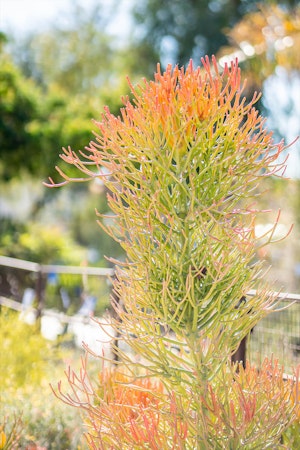
- Firesticks Succulent Cactus (Euphorbia tirucalli)
These make a beautiful addition to any landscape. They are easy to grow and can survive in low temperatures that are just below freezing. Firesticks have many names: Milk Bush, Naked Lady or Pencil Tree. With green stems and blooms that range from yellow to red, they are simply eye catching.
Full sun to partial shade. Once established, has low water needs. Water sparingly, allow the soil to dry out between watering.
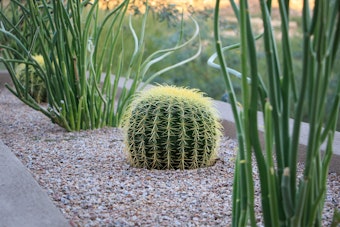
- Golden Barrel (Echinocactus grusonii)
The Golden Barrel cactus originated from Mexico and are now considered rare and endangered in the wild. They are slow to grow and offers yellow blooms but not until the cactus is at it’s maturity. Golden Barrel cacti can be grown outdoors in areas with mild winter temperatures. Their barrel shape is a nice companion to many other varieties of cacti.
Full sun. Once established, has low water needs. Water sparingly, allowing the soil to dry out between watering.
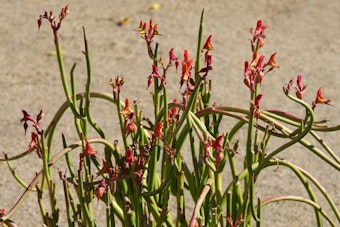
- Lady Slipper Succulent Cactus (euphorbia lomelii - formerly Pedilanthus macrocarpus)
The Lady Slipper Succulent is a distinctive and attractive plant that is characterized by its slender, cylindrical gray-green stems that grow upright to about 3 feet tall. This plant's smooth stems are often mistaken for cacti. It produces small, slipper-shaped reddish or orange flowers at the tips of its stems, attracting pollinators like hummingbirds. The plant has minimal leaves, which drop off quickly, leaving the stems as the main feature. Highly tolerant of heat and occasional frost, it thrives in well-draining soil, such as a cactus or succulent mix. The Lady Slipper Succulent is generally low-maintenance, requiring minimal pruning.
Prefers full sun to partial shade. While it can tolerate intense sunlight, providing some afternoon shade can help prevent sunburn on the stems during the hottest part of the day. Once established, it has low to moderate water needs. Water deeply but infrequently, allowing the soil to dry out between watering sessions. During the summer months, it may require more frequent watering, while in the winter, watering should be reduced to prevent overwatering.
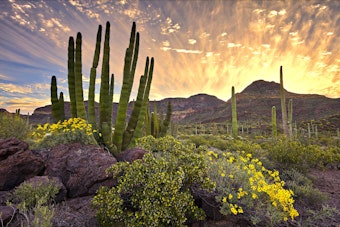
- Organ Pipe Cactus (Stenocereus thurberi)
Next to the Saguaro, the Organ Pipe Cactus is the second largest in the United States. The trunks of these cacti are as large as 6 inches in diameter and rather than having a single stem like the saguaro, it has 5 to 20 branches that grow from ground level up. The pulp of the organ pipe cactus can be made into jelly and eaten or fermented into a beverage. They were a food source for Native Americans for centuries.
Full sun. Once established, has low water needs. Water deeply and infrequently, allowing the soil to dry out completely between watering.
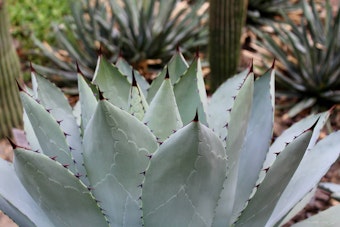
- Parry's Agave Cactus (Agave parryi)
Much like the American Agave, it’s an incredibly tough and slow growing plant. It grows to just under 2ft. tall and 3 ft. wide. Drought tolerant, the Parry’s Agave prefers dry or moist soil and thrives in full sun. The flowers of the Parry’s Agave are lovely and fragrant and attractive to bees, butterflies and birds.
Full sun. Once established, has low water needs. Water deeply and infrequently, allowing the soil to dry out completely between watering.
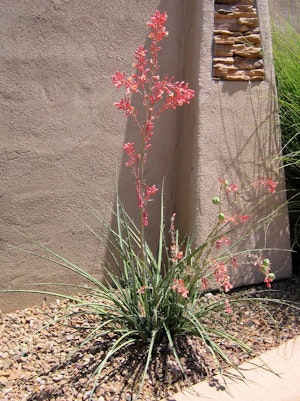
- Red Yucca (Hesperaloe parviflora)
Red Yucca, is adored by all including bees, butterflies, birds and hummingbirds. It appears in mounds, with fountain-like leaves from the base. The colors of their bell shaped flowers bloom from May through October and in stunning reds to coral tones. Red Yucca is one tough plant, enduring both the extreme heat and cold. It is a much nicer plant to brush up against as the leaves are not spine-tipped (like the agave). Great as an accent plant and does well in container gardens.
Full sun to partial shade. Once established, has low water needs. Water deeply and infrequently, allowing the soil to dry out between watering.
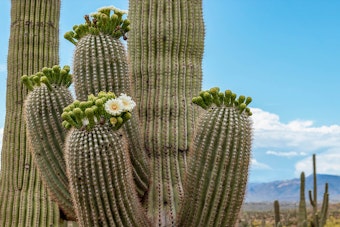
- Saguaro Cactus (Carnegiea gigantea)
The saguaro cactus is the epitome of what one thinks of for a cactus. They are large columnar tree-like cacti that grow arms or branches as they get older. The arms typically bend at what we would call the elbow and grow upward. Like all plants, the right amount of water and temperature are key to the life of the saguaro. With the right growing conditions, they can live as long as 200 years. Incredibly with the exception of one main root that grows down around 2 feet, the saguaro’s roots grow only 4 to 6 inches deep but they radiate out as far as the tree is tall. Saguaro’s columnar stature is covered with protective spines and offers lovely white flowers in the lat spring and red fruit during summer. The saguaro cactus is a statement piece all on it’s own.
Full sun. Once established, has very low water needs. Water sparingly, only during prolonged drought periods.
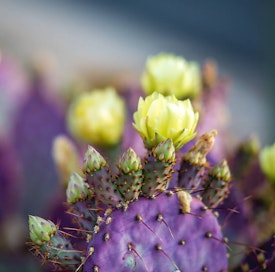
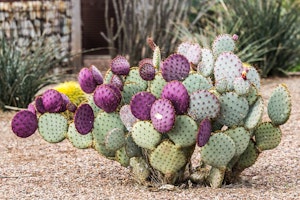
- Santa Rita Prickly Pear Cactus (Genus Opuntia)
Once established, the Prickly Pear Cactus is a very drought tolerant plant. It prefers full sun and well-drained soil to thrive. It’s beautiful color offers a lovely contrast to other Southwestern plants. Birds and rabbits too like the Prickly Pear Cactus for it’s fruit and nesting sites. That same fruit can be make into jams and jellies and the pectin from this plant is linked to lowering bad cholesterol. It ranges in size from 12 inches up to 6 ft. tall and can span in various sizes in width. Color, contrast and shape make this cactus a great addition to any Sonoran Desert landscape.
Full sun. Once established, has low water needs. Water sparingly, allowing the soil to dry out completely between watering.
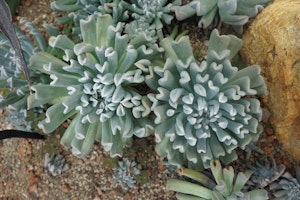
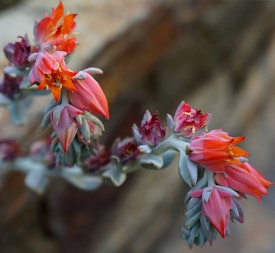
- Topsy Turvy (Echeveria Runyonii)
The Topsy Turvy plant offers blue-green and silver dusted leaves that are curled and folded and grow in low growing clumps. These clumps are like rosettes that spread quickly in your garden. Each rosette can grow to the size of a dinner plate. And like many, the Topsy Turvy will produce from it’s center, a cluster of pretty orange flowers in late summer or early fall. These stunning little flowers are great for attracting hummingbirds. Their delicate and tender succulent leaves grow best under cover and act as a wonderful accent to any garden container or rock garden.
Full sun to partial shade. Once established, has low water needs. Water deeply but infrequently, allowing the soil to dry out between watering.
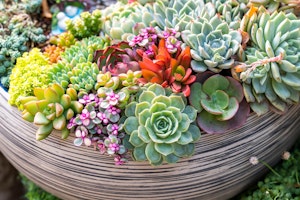 Care for Cactus in Containers
Care for Cactus in Containers
Cacti do well in containers under the right conditions. Click below for recommendations on how to help your cacti prosper.

